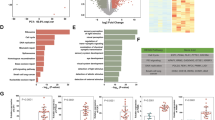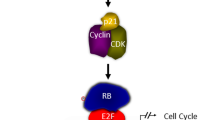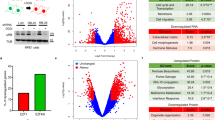Abstract
The E2F family of transcription factors are critical regulators of the cell cycle and have also been implicated in apoptosis, development, DNA damage checkpoints, and differentiation. Retinoblastoma (Rb) proteins interact with E2F to regulate transcription, and several mechanisms have been proposed for Rb-E2F transcriptional regulation. We designed microarray-based experiments to characterize the relative contributions of each mechanism, and unexpectedly, we found that distinct functional gene groups show preference for one mechanism over the others. We propose that such a distribution may provide signaling specificity to enable regulatory proteins to turn on or off entire pathways that determine cell fate.
This is a preview of subscription content, access via your institution
Access options
Subscribe to this journal
Receive 50 print issues and online access
$259.00 per year
only $5.18 per issue
Buy this article
- Purchase on SpringerLink
- Instant access to full article PDF
Prices may be subject to local taxes which are calculated during checkout

Similar content being viewed by others
References
Brehm A, Miska EA, McCance DJ, Reid JL, Bannister AJ and Kouzarides T . (1998). Nature, 391, 597–601.
Croxton R, Ma Y, Song L, Haura EB and Cress WD . (2002). Oncogene, 21, 1359–1369.
Dalton S . 1992. EMBO J., 11, 1797–1804.
Dunaief JL, Strober BE, Guha S, Khavari PA, Alin K, Luban J, Begemann M, Crabtree GR and Goff SP . (1994). Cell, 79, 119–130.
Dyson N . (1998). Genes Dev., 12, 2245–2262.
Flemington EK, Speck SH and Kaelin Jr WG . (1993). Proc. Natl. Acad. Sci. USA, 90, 6914–6918.
Geng Y, Eaton EN, Picon M, Roberts JM, Lundberg AS, Gifford A, Sardet C and Weinberg RA . (1996). Oncogene, 12, 1173–1180.
Harbour JW and Dean DC . (2000). Genes Dev., 14, 2393–2409.
Harbour JW, Luo RX, Dei Santi A, Postigo AA and Dean DC . (1999). Cell, 98, 859–869.
Helin K, Harlow E and Fattaey A . (1993). Mol. Cell. Biol., 13, 6501–6508.
Hiebert SW, Chellappan SP, Horowitz JM and Nevins JR . (1992). Genes Dev., 6, 177–185.
Hsiao KM, McMahon SL and Farnham PJ . (1994). Genes Dev., 8, 1526–1537.
Ishida S, Huang E, Zuzan H, Spang R, Leone G, West M and Nevins JR . (2001). Mol. Cell. Biol., 21, 4684–4699.
Johnson DG, Ohtani K and Nevins JR . (1994). Genes Dev., 8, 1514–1525.
Johnson DG, Schwarz JK, Cress WD and Nevins JR . (1993). Nature, 365, 349–352.
Kalma Y, Marash L, Lamed Y and Ginsberg D . (2001). Oncogene, 20, 1379–1387.
Koziczak M, Muller H, Helin K and Nagamine Y . (2001). Eur. J. Biochem., 268, 4969–4978.
Lam EW and Watson RJ . (1993). EMBO J., 12, 2705–2713.
Luo RX, Postigo AA and Dean DC . (1998). Cell, 92, 463–473.
Ma Y, Croxton R, Moorer Jr RL and Cress WD . (2002). Arch. Biochem. Biophys., 399, 212–224.
Magnaghi-Jaulin L, Groisman R, Naguibneva I, Robin P, Lorain S, Le Villain JP, Troalen F, Trouche D and Harel-Bellan A . (1998). Nature, 391, 601–605.
McConnell BB, Gregory FJ, Stott FJ, Hara E and Peters G . (1999). Mol. Cell. Biol., 19, 1981–1989.
Means AL, Slansky JE, McMahon SL, Knuth MW and Farnham PJ . (1992). Mol. Cell. Biol., 12, 1054–1063.
Muchardt C and Yaniv M . (1999). Semin. Cell. Dev. Biol., 10, 189–195.
Muller H, Bracken AP, Vernell R, Moroni MC, Christians F, Grassilli E, Prosperini E, Vigo E, Oliner JD and Helin K . (2001). Genes Dev., 15, 267–285.
Neuman E, Flemington EK, Sellers WR and Kaelin Jr WG . (1994). Mol. Cell. Biol., 14, 6017–6615.
Nielsen SJ, Schneider R, Bauer UM, Bannister AJ, Morrison A, O'Carroll D, Firestein R, Cleary M, Jenuwein T, Herrera RE and Kouzarides T . (2001). Nature, 412, 561–515.
Ohtani K, DeGregori J and Nevins JR . (1995). Proc. Natl. Acad. Sci. USA, 92, 12146–12150.
Polager S, Kalma Y, Berkovich E and Ginsberg D . (2002). Oncogene, 21, 437–446.
Reed SI . (1997). Cancer Surv., 29, 7–23.
Ren B, Cam H, Takahashi Y, Volkert T, Terragni J, Young RA and Dynlacht BD . (2002). Genes Dev., 16, 245–256.
Sears R, Ohtani K and Nevins JR . (1997). Mol. Cell. Biol., 17, 5227–5235.
Sherr CJ . (1996). Science, 274, 1672–1677.
Suzuki A and Hemmati-Brivanlou A . (2000). Genes Dev., 5, 217–229.
Takahashi Y, Rayman JB and Dynlacht BD . (2000). Genes Dev., 14, 804–816.
Trimarchi JM and Lees JA . (2002). Nat. Rev. Mol. Cell Biol., 3, 11–20.
Tusher VG, Tibshirani R and Chu G . (2001). Proc. Natl. Acad. Sci. USA, 98, 5116–5121.
Vandel L, Nicolas E, Vaute O, Ferreira R, Ait-Si-Ali and Trouche D . (2001). Mol. Cell. Biol., 21, 6484–6494.
Wade M, Kowalik TF, Mudryj M, Huang ES and Azizkhan JC . (1992). Mol. Cell. Biol., 12, 4364–4374.
Wang J and Walsh K . (1996). Cell Growth Differ., 7, 1471–1478.
Weinmann AS, Yan PS, Oberley MJ, Huang TH and Farnham PJ . (2002). Genes Dev. 15, 235–244.
Zhang HS, Postigo AA and Dean DC . (1999). Cell, 97, 53–61.
Acknowledgements
We thank Mark Watson, Kate Hamilton, and Laura Voss for their help and advice on microarrays, and Douglas Dean for intellectual contribution and support in the early stages of this work. This work was supported by grants from the National Institutes of Health (CA 85839) and the American Heart Association (EI9940116N) to GDL.
Author information
Authors and Affiliations
Corresponding author
Rights and permissions
About this article
Cite this article
Young, A., Nagarajan, R. & Longmore, G. Mechanisms of transcriptional regulation by Rb-E2F segregate by biological pathway. Oncogene 22, 7209–7217 (2003). https://doi.org/10.1038/sj.onc.1206804
Received:
Revised:
Accepted:
Published:
Issue date:
DOI: https://doi.org/10.1038/sj.onc.1206804
Keywords
This article is cited by
-
Activated Src requires Cadherin-11, Rac, and gp130 for Stat3 activation and survival of mouse Balb/c3T3 fibroblasts
Cancer Gene Therapy (2022)
-
Human papillomavirus-mediated carcinogenesis and tumor progression
Genome Instability & Disease (2021)
-
An Rb1-dependent amplification loop between Ets1 and Zeb1 is evident in thymocyte differentiation and invasive lung adenocarcinoma
BMC Molecular Biology (2015)
-
p38 phosphorylates Rb on Ser567 by a novel, cell cycle-independent mechanism that triggers Rb–Hdm2 interaction and apoptosis
Oncogene (2011)
-
Accelerated DNA replication in E2F1- and E2F2-deficient macrophages leads to induction of the DNA damage response and p21CIP1-dependent senescence
Oncogene (2010)



